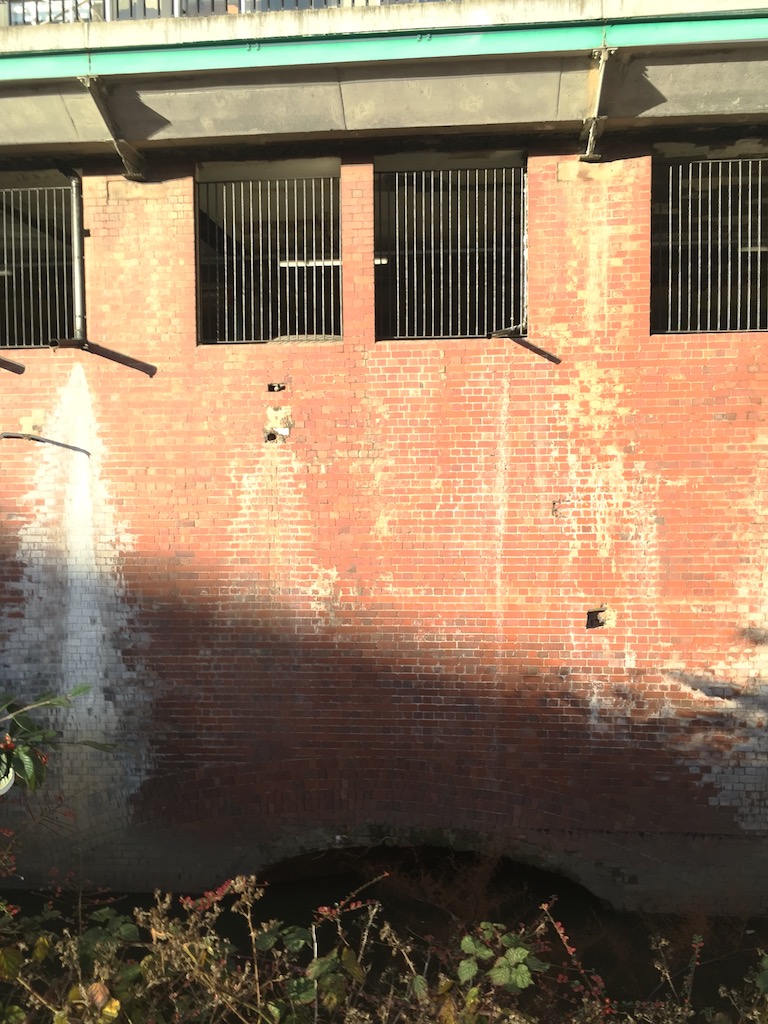> Dukes Tunnel 📍
This tunnel leads from a previous lower level Medlock to a point just underneath the present day station approach, and was used to carry coal from the Worsley mines to the station.

Before the current layout of canals, back when the Medlock was navigable by barges, it was used to transport coal on ships from the Duke’s mines out at Worsley to Bank Top close to Piccadilly Station. They did this by leaving the Medlock at Garrett Dye Works and travelling through a route known as Duke’s Tunnel.
The tunnel was completed by 1789 and its route can be seen on maps in Underground Manchester. The mouth of the tunnel is still visible along the Medlock from the train going past, and it is possible to see how much the Medlock has silted up from the fact that only the top of the arch is visible. I’ve read anecdotal claims that the tunnel was somehow connected to Shooter’s Brook, which would have joined the Medlock near to the mouth of the tunnel, and apparently kids used to be able to dive beyond the bottom of the brook, into the tunnel and retrieve coal which had been left behind.
I’ve plotted the tunnel’s route using maps and documents in Underground Manchester by Keith Warrender on pages 34–37, and from old OS maps of the area. I’ve placed pins on locations of shafts to the surface marked on maps.You can see a photo of the entrance to the tunnel on Castlefield Canal Heritage Walk.
This tunnel was completed in 1789 and was 650 yards in length, 8ft 6ins high and 6 feet wide. Judging by the narrow width and lack of towpath the boats used must have been ‘Starvationers’… the type of compartment boat used inside the Worsley Mines. At the coal face the coal they carried was loaded into wooden containers which fitted in between the exposed ribs inside the boats (hence the name ‘Starvationers’). The boats were ‘legged’ through the tunnel and the coal delivered to the end at Bank Top close to the approach to Piccadilly Station. Once at the end of the tunnel, near the junction of London Road and Ducie Street, the wooden coal containers were winched to the surface by a horse gin… a horse-powered hoist for delivery to the adjacent Knowles and Sons Coal Yard. The River Medlock was gradually made un-navigable by about 1800 due to adjacent factories and mills disposing of cinders and other rubbish into it causing it to silt up.
On 7th August 2008 someone walking through area of the Ashton basin noticed some roadworks exposing what might be the remains of the tunnel, if it were to join up with the Ashton Canal. Alternatively they may have been seeing another tunnel off Store Street.
I wandered down to the mills on Redhill Street, to think about the tunnel to the basin. Unfortunately, roadwork’s stopped me from looking at what I wanted, but on the other hand, I was diverted down Murray Street and back by Bengal Street. Bengal Street offers an excellent view of the partly excavated basin.
I wandering around and after I’d looked at all that I’d gone into town and was heading home, I hit the jackpot.
Walking down Ducie Street, stopped to peer into the big hole in the road just by Avis. An arch probably about six feet wide and undetermined height. It might be a tunnel, it might be a door or window opening, with a large digger working on the hole it wasn’t easy to get a good view. What inclines me toward tunnel is that it had been filled with concrete and looked as if the excavation had cut through it. It is only a few feet below the surface and runs parallel to London Road.
If anybody is in the area with a camera in the near future it might be worth recording. Yes, I know I should have had mine, but it’s getting so old I’m almost embarrassed to be seen with it
Information was provided on a Mining History mailing list about the Dukes Tunnel.
A second tunnel (the 'navigable sough level' a-which was also a feeder for the Bridgewater Canal) was opened in 1789 and ran from the River Medlock at a point above Oxford Road for a distance of around 620 yards (another source says 649 yards) to an underground wharf at Bank Top from whence the coal was raised up a shaft of about 80ft to a coal wharf on London Road. This is thought to have been abandoned when the nine locks of the Rochdale Canal up to Picadilly were completed in 1800. I am advised that you can see the entrance to this tunnel, but I have not yet found the spot.
Grace’s Guide mentions in passing the tunnel in discussing problems with flooding of the River Medlock, quoting this passage from the Manchester Courier and Lancashire General Advertiser.
Perhaps a great proportion the present inhabitants have no idea of the state of London-Road, scarcely twenty years since. Two drums and windlasses, with geering, etc. for raising coal, then stood on the site of the present foot-path, on the north side, between Ducie-Street and Store-street. Coals were then raised from eyes or shafts, which had the appearance of two coal-pits. But the coals were not dug there, but brought in the Duke of Bridgewater's boats from Knott-Mill upon the river Medlock to Garratt, and from thence by a tunnel to this place.
The coal wharf at the bottom of station approach mentioned in the above article can be seen on the 1851 Manchester & Salford Ordnance Survey, sheet 29. Zoom into the bottom-middle of the map.
 Hidden Manchester Map
Hidden Manchester Map